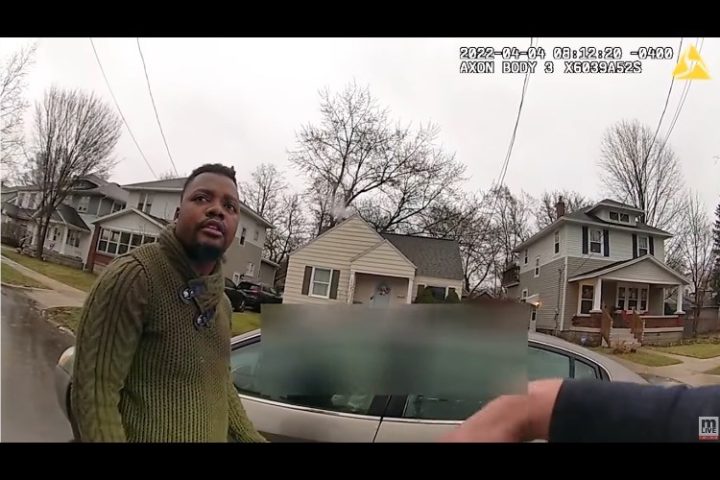
The shooting death of a black man by a white police officer early last week in Grand Rapids, Michigan, has potential to become the next salvo in the War on Cops. It bears enough similarity to prior events — a white officer, a black man resisting arrest and fighting with the officer, and a high-profile civil-rights lawyer claiming the shooting was an “execution” — to make Patrick Lyoya the next George Floyd. If that happens, it could mean another round of BLM/Antifa protests across America.
While the shooting is a developing story and there is much we do not know, there is also much that we do know. Just after 8:00 a.m. on April 4, 26-year-old Patrick Lyoya — a refugee from the Democratic Republic of the Congo who had been living in Grand Rapids for the past five years — was pulled over because the license plate on his car was from another vehicle. Lyoya ignored the officer’s orders to stay in the vehicle and would not produce a license when asked. After a brief argument, during which Lyoya was uncooperative, the officer attempted to place him under arrest.
Lyoya actively resisted, breaking away from the officer and running. The officer tackled Lyoya in a neighboring lawn and again attempted to arrest him. Lyoya fought with the officer, and when the officer drew his Taser, Lyoya grabbed it and tried to take it from the officer. The two struggled for a minute or so, the officer telling Lyoya the whole time to “let go of the Taser.” When Lyoya gained control of the Taser, the officer drew his gun. Lyoya was face-down with the officer on Lyoya’s back. The officer pointed his weapon at Lyoya’s head and ordered Lyoya to “drop the Taser” and Lyoya refused. At this point, the officer fired one shot, striking Lyoya in the back of the head, killing him.
All of the above was captured on video and is available online. Much of it was captured by the officer’s body camera. Though the camera was deactivated during the struggle and does not show the fatal shot, it does show the events leading up to the shooting.
What the body camera does not show is filled in by mobile-phone video recorded by Lyoya’s friend who was a passenger in the car Lyoya was driving.
As can clearly be seen in the videos, Lyoya was reasonably suspected of the crime of driving a car with plates from another car. He refused to provide a driver’s license. He resisted arrest and physically fought with the officer. He escalated the situation to a dangerous level and then wrestled a Taser away from the officer.
Since the very purpose of a Taser is to incapacitate a person by causing an electirc interruption to the central nervous system, having a suspect take one away from a police officer in a struggle is not an option. Plainly put, at the very moment Lyoya took the Taser from the officer, he became an armed suspect in an altercation with a police officer. He could have used the Taser on the officer and then — while the officer was incapacitated — taken the officer’s gun.
Given the circumstances, the officer’s decision to shoot Lyoya was reasonable and within both the law and department policy. Grand Rapids Police Department policy on use of force states that officers may:
Use deadly force only to defend themselves, another officer, or another person against a reasonable threat of death or serious bodily injury; or to prevent the escape of a subject who is fleeing from an inherently violent felony crime, when the officer has probable cause to believe the subject poses a reasonable threat of death or serious bodily injury to the officer or others.
The policy is clear in stating:
Whenever reasonably possible, officers shall provide verbal directives before deadly force is used.
Any reasonable, unbiased person watching the above videos would have to conclude that Lyoya was armed and that he was attempting to escape a felonious assault of a police officer. Further, they would have to conclude that — being armed with the Taser he had just taken from the officer in a violent and felonious assault — he posed “a reasonable threat of death or serious bodily injury” to at least the officer.
Finally, they would have to conclude that the officer’s command to “let go of the Taser” and “drop the Taser” — which the officer repeated five times — clearly constitutes providing “verbal directives before deadly force is used.”
But that would be the conclusion of a person who was reasonable and unbiased. Unfortunately, that is not the case for many of those watching these videos. The Lyoya family has retained the services of Ben Crump, who is famous for raking the coals of racism and excessive force in high-profile cases in the recent past. For instance, his name is inseparable from the cases of Michael Brown, Ahmaud Arbery, George Floyd, and Breonna Taylor, who — besides being black people killed by police officers — were also all involved in criminal activity at the time of their deaths.
Crump has been called “Black America’s Attorney General” and he appears to relish the title, going after cases such as this, facts be damned. Crump and his allies in major media, politics, and BLM have already turned Lyoya into a hashtag hero and victim. They have also already tried and convicted the officer in the court of public opinion and want to do the same in criminal court.
As soon as the video — showing that the officer’s actions were reasonable — was made public, protests began in and around Grand Rapids and Crump did what he does best: He took to the cameras, describing Lyoya’s death as another “execution” of a black man by police.
Governor Gretchen Whitmer — who is likely glad to have the attention on something besides her fake kidnapping attempt — and her fellow Democrats in the Michigan legislature called for “accountability and transparency” for the “murder” of a poor “refugee” who was in America “fleeing violence.” And the president of the Flint chapter of BLM — Dewaun Robinson — is milking the death of another black man for all it’s worth.
In a statement to media, Robinson said:
It just makes me so angry. I’m just hurt. My blood is boiling. My skin is crawling. And just to see another young man right after these incidents that we’ve been having — in a wave of incidents we’ve been taking place these last couple years — it’s a rerun.
Describing his reaction to the video, Robinson said, “It could easily be me down there on the ground.”
Here is a tip for the Robinsons of the world: Yes, it could have been you. But it could have been this middle-aged, white writer, too. It could have been anyone who escalates a traffic stop into a life-and-death fight with a police officer. The takeaway: Don’t resist arrest, fight a cop, and take his Taser away from him, and it likely won’t be you “down there on the ground.”
With national attention on this shooting of a black man by a white officer and BLM and Crump involved, all the ingredients are assembled for another wave of BLM terrorism like that seen in the months after the death of George Floyd. All that’s left is to mix and bake. And that is where the liberal media come in.
While one can hope that this anti-white, anti-cop hate cake will flop in the oven, it is wise to note what happened just a short couple of years ago. In the wake of Floyd’s death, BLM and Antifa burned and pillaged their way through more than 200 American cities, doing billions of dollars in damage and setting aside decades of gains in race relations — and they did so all in the name of “racial equality” and “justice.”
God spare us from more of their “racial equality” and “justice.”




